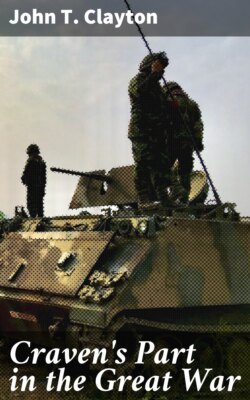Читать книгу Craven's Part in the Great War - John T. Clayton - Страница 20
На сайте Литреса книга снята с продажи.
IN THE FRONT LINE.
ОглавлениеTable of Contents
The first portion of the battalion, consisting of the Transport and Machine Gun section, left Doncaster on the night of April 12th, 1915, and crossed from Southampton to Havre on the night of 13/14th April. The remainder of the battalion crossed by a more direct route to Boulogne on the following day, and after a long and weary march joined the same train at Hesdigneul on the 15th. The re-united battalion travelled on by the sleepy little branch line through Lumbres to St. Omer and then forward to Merville where they detrained at 11–30 p.m. After unloading horses, mules and waggons, the whole battalion set off on a three-mile march to Neuf Berquin. What with the darkness and the unfamiliar language, the task of billeting was no easy one, but all the men were got under shelter before dawn and enjoyed a well-earned repose in their first French billets.
The names of the officers who went overseas with the battalion, noting the casualties which occurred among them, may be given here as some indication of the severe fighting through which the battalion passed. Many of the officers given as wounded were hit more than once: and the casualties among the other ranks were in much the same proportion:—
Lieut.-Col. J. Birkbeck, of Settle, commanding officer; Major C. P. Cass, of Keighley, second in command; Adjutant, Capt. S. F. Marriner. Company commanders—Major C. M. Bateman (wounded) (A), Capt. A. B. Clarkson (wounded) (B) Capt. N. B. Chaffers (C) and Capt. T. K. Wright (D), with Capt. H. Dixon, Capt. C. H. Sarsby (wounded), Capt. E. G. Whittaker and Capt. K. Nicholson as their respective seconds-in-command. The platoon officers were Lieuts. M. Law (killed), Supple (killed), H. Knowles (killed), C. H. Petty (wounded), C. Horsfall (killed), 2nd Lieuts. F. L. Smith (wounded), K. Ogston (killed), V. W. Greaves, T. S. Whitaker (killed), L. Jaques (wounded), N. Geldard (wounded), R. C. Barrett, T. Brayshaw (wounded) and Stuck (wounded). The quarter-master was Lieut. J. Churchman, D.C.M; Signalling officer, Lieut. A. Slingsby (killed); Transport officer, Lieut. S. H. Clough (wounded); Machine Gun officer, 2nd Lieut. R. M. Robinson, and Medical Officer, Lieut. A. C. Haddow (wounded).
2nd Lieut. G. Buxton (wounded) and 2nd Lieut. Coulthurst (killed), who were on the sick list at the time, followed the battalion a few weeks later, and Capt. M. Wright, who was left behind to organize a nucleus company to provide reinforcements, himself came out with a draft during the early autumn.
Major General Baldock was in command of the Division and Brig.-General E. F. Brereton of the brigade.
Arrived at Neuf Berquin the 6th Duke’s was not allowed to remain idle. After three days’ rest the battalion was taken up by detachments for trial trips to the trenches and on April 26th the brigade took over from the London Regiment a portion of the line in front of Fleurbaix. It was at this time that the First West Riding Division became the 49th; the 2nd West Riding Brigade, consisting of the 4th, 5th, 6th and 7th Duke of Wellington’s Regiments, became the 147th Infantry Brigade, the whole being attached to the Indian Corps in the First Army.
In after days men commonly looked back on the Fleurbaix era as a time of peace and plenty. It is true that the weather was good and the life not too strenuous. But the sniping was unusually severe. Few reliefs took place without a casualty and the shelling of billets was a far from comfortable novelty. The way the battalion settled down to work in its new surroundings augured well for the future.
On May 9th the men were spectators of one of those early attacks which cost so much and gained so little. The limit of the main attack was the right of the 6th Battalion; and if it had been successful the battalion was also to advance and take a part. But backed by insufficient artillery and faced by relentless machine gun fire, the attack failed to reach the foot of the Aubers Ridge, and the battalion was ordered to stand fast in its trenches. It was a day of tense anxiety and the battalion was lucky to have so few casualties. The signallers especially distinguished themselves, mending the lines back to the brigade as soon as they were cut by shellfire; and few will forget the picture of Lieut. Anthony Slingsby striding upright across the open, while he sternly commanded some diminutive signaller beside him to “keep his head down.”
Quieter days followed, and on June 26th the brigade left those trenches for the last time, handing them over to their gallant fellow-territorials of the 51st Division. The battalion was no longer raw: it had seen its dead. One officer (Lieut. Knowles) had been killed in a bombing accident, and two (Lieut. Petty and Capt. Sarsby) had been severely wounded. About twenty other ranks were among the casualties. And the old grey walls of the ruined abbey, with its little fishpond and the stately remnants of its tower, will always be remembered by those who helped to defend it.
